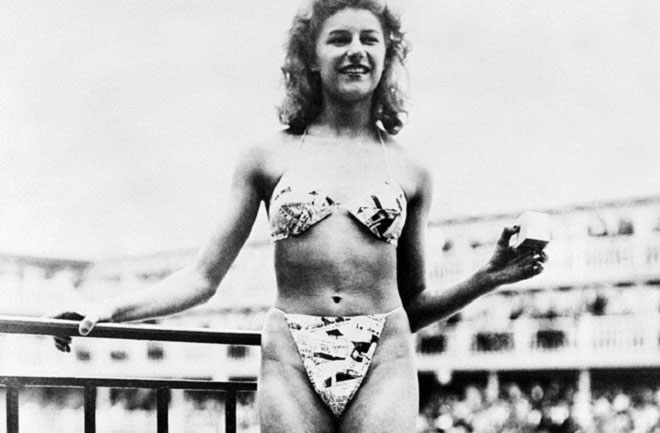10 products that change the lives of anonymous inventors
The fever of wrapped skirts, bikinis, super glue is more famous inventions than the names of inventors.
1. Bikini

Photo: Bettmann / Corbis.
In 1946, Jacques Heim, a female costume designer in Cannes, France, was the first to design a two-piece swimwear called "Atome" , named after Atom in French as an atomic bomb. Heim hired a plane to release the words "Atome, the smallest swimwear in the world" in heaven promoting costumes.
Three weeks later, automotive designer Louis Reard came up with a new idea of a more economical version of two-piece swimsuits. Reard uses less than 200 square centimeters of fabric for the new design, in which two triangles are connected by thin ribbons to form a bra. The design is named "bikini" , a coral island that tests American nuclear weapons in the Pacific Ocean.
Promoting his design, Louis Reard claimed that the bikini was "smaller than the smallest swimwear in the world" and said the two-piece swimwear could not be called a bikini unless it came under a wedding ring.
2. Swiss fitness ball

Photo: Listverse.
Unlike the so-called Swiss gymnastics ball, fitness balls were invented in 1963 by Aquilino Cosani, an Italian plastic manufacturer. Cosani initially invented an explosion-proof vinyl ball called "Gymnastik" in various sizes for the purpose of making toys.
Dr. Elseth Kong and Mary Quiton, British physiotherapists in Switzerland then used the ball to develop a rehabilitation program for newborns with cerebral palsy. In general, Swiss physiotherapist Susan Klein-Vogelbach also used functional rehabilitation exercise balls for orthopedic patients in Basel, Switzerland.
In the 1970s, Dr. Joanne Posner-Mayer observed the effect of fitness balls during a visit to Copenhagen; then bring the ball to the US introduction.
3. Rubber gum

Photo: Listverse.
In 1770, the first version of rubber gum was introduced on the market by Edward Nairine, a British ophthalmologist and engineer. The idea came from once when Nairine tried to take breadcrumbs to remove the stain, but picked up a piece of rubber nearby.
After discovering the eraser application of rubber, Nairbe began advertising and selling rubber blocks for bleaching.
At the end of 1770, British chemist Joseph Priestly happened to observe this property of rubber, naming it "eraser" , to refer to the ability to erase pencil marks.
The first version of the gum is fragile and smelly. By 1839, both problems were solved by Charles Goodyear by the process of vulcanizing rubber.
The first pencil mounted with gum appeared in 1858 thanks to the idea of Hymen L. Lipman. However, Lipman was not allowed to receive a patent in the US at the moment because the council thought it was just a combination of two inventions available.
A decade later, Lipman was recognized for copyright and built the company Faber to produce a pink pencil model for sale. Today, besides rubber latex, gums are also made from synthetic materials such as those made of rubber plastic, but others are made of synthetic materials such as styrene and butadiene.
4. Wax Vaseline

Photo: Listverse.
Wax Vaseline is well known for the treatment of dry lips, skin moisturization and disinfection as the invention of British chemist Robert Chesebrough.
At the age of 22, during a research trip at the new oil field in Titusville, after observing the workers applied a substance that was sticking to the cut of the hand and the burn, Chesebrough decided to bring it to the experiment.
Cheesebrough received a patent by distilling the most efficient component of the wax and starting selling it as Vaseline in 1870. With the determination to turn Vaseline into a family product, Chesebrough did it himself. Cut off and cause burns with acid or fire and rub Vaseline to prove the product's healing properties. Chesebrough also said he used to eat a spoonful of Vaseline every day.
5. Can open tool

Photo: Listverse.
In 1828, British merchant Peter Durand received a patent for inventing food storage by putting it in tin cans. Nearly three decades later, the can opener was replaced by the manual opening with hammers and chisels.
On July 13, 1855, Robert Yates, the Middlesex, he received a patent for the first can opener with a curved blade and a knife.
In the late 1859s, tin cans were thinner, serving as the basis for Ezra Warner's can opener version of Connecticut, USA. However, the initial designs all require a lot of effort, so they are not popular in families.
In 1870 William Lyman invented a family-friendly can opener, consisting of a pointed tip hitting the center of the lid of the box, the adjustable lever clamped to the can and the blade around the edge of the box.
In 1925, Star Group specialized in manufacturing cans to improve tools by removing the tip of the lid on the can, named Feed Wheel.
6. Super glue

Photo: Omegatron / Wikimedia.
American Dr. Harry Coover accidentally discovered the super sticky substance when developing a transparent plastic gun sight for the Allies in 1942. Coover and his team discovered that a group of cyanoacrylates does not bring the desired properties because they stick Tight on all surfaces. The idea with cyanoacrylate groups is therefore canceled.
In 1951, Coover worked for Kodak chemical factory in Kingsport, Tennessee to study thermoplastic polymers for jets.
The cyanoacrylate group continues to be tested and failed, but Coover recognizes the value of the cyanoacrylate at its own adhesive properties. In the late 1950s, he launched the super glue product called "Eastman 910".
7. Wrap skirt

Photo: Refinery29.
The dress dress is the idea of Belgian designer Diane von Furstenberg. Starting with the knowledge of fashion is nil, Furstenberg entered an apprenticeship in a fabric factory Angelo Ferretti in Italy in 1969. In the 1970s, Furstenberg entered the fashion village of New York, USA.
The idea of a dress in the world fashion village in the 70s appeared when Furstenberg accidentally saw President Nixon, Julie Nixon Eisenhower's daughter, dressed in a skirt and shirt wrapped on television. Furstenberg's swaddling skirt was a product that combined two of one of Julie's costumes.
According to Listverse, the first wrapped skirt made of jersey, long-sleeved and waist-wearing became a phenomenon when it first debuted in 1976 and quickly sold more than 5 million products.
8. Surfboard

Photo: Listverse.
In ancient Hawaiian society, skateboarding is a recreational activity that symbolizes spiritual and cultural life. Hawaiians often pray to the gods to give good waves and woods of Koa, Wili Wili and Ula to make surfboards. However, after Captain Cook and European missionaries arrived in the 18th and 19th centuries, surfing gradually disappeared until the beginning of the 20th century.
The new era of surfboards began in 1926, when Tom Blake invented the empty surfboard. The board is about 4.5 m long and has hundreds of drill holes inside, covered with thin wood panels on the top and bottom. Blake then added the "tail fin" to increase the ability to control the board for surfers.
9. Tampon

Photo: Listverse.
America invented in 1931. At that time, he registered for Tampax for his product.
In 1934, a group of investors bought Dr. Haas's patent and began to widely introduce Tampax to the market completely alien to this new product.
The first advertisement on Tampax in July 1936 states: "Your doctor will be the first to assert Tampax is a natural hygiene method accepted by the American Medical Association (AMA)". However, in fact, AMA approved this product until 1945.
In the article published in AMA's Journal, Dr. Robert L. Dickenson analyzed and analyzed the reasons he supported the use of tampon. Dickenson thinks tampons are superior because conventional tampons are easy to smell, irritate and make them feel uncomfortable when used.
10. Water spray gun

Photo: Listverse.
Lonnie G. Johnson, an engineer working for NASA and the US Air Force, is the father of more than 40 idea rights, the most famous being a water gun for children.
In 1982, while doing experiments with heat pumps, using water instead of Freon. When connecting the pump to the tap and unlocking it, high-pressure water immediately shot into the tank, inspiring Johnson to shift his ideas to developing a water gun.
After combining with two unsuccessful companies with the original design, in 1989 Johnson met Myung Song, Chairman of Larami Group, presented an innovative model.
Larami decided to change the name of the product from "Power Drencher" to "Super Soaker" , apply for a patent for a water gun and sell an attractive toy to millions of children around the world.
- 10 talented young inventors under the age of 18
- Strange inventions in the world
- Anonymous claims NASA is about to make an important announcement about alien life
- Super products created by nanotechnology
- Published from NASA responds Anonymous: What life there is no alien life
- Agricultural biotechnology is changing lives
- Innovations that change lives
- Chinese inventors 'suck' millions of fans through crazy inventions
- What is Climate Change?
- 'Engineer' in the African field
- Anonymous creatures and extinct endings
- Discovered the 4500-year-old tomb of the anonymous Egyptian queen
 Daily use inventions come from universities
Daily use inventions come from universities Special weight loss device helps prevent appetite
Special weight loss device helps prevent appetite 8 inventors were killed by their own inventions
8 inventors were killed by their own inventions Iran invented a motor car powered by water
Iran invented a motor car powered by water Photos capture Shanghai's golden age, every frame is as beautiful as a movie
Photos capture Shanghai's golden age, every frame is as beautiful as a movie  Revealing a series of rare photos recording little-known things in history
Revealing a series of rare photos recording little-known things in history  Top 9 Gods in 'Greek Mythology'
Top 9 Gods in 'Greek Mythology'  Photographs of Chinese Women 150 Years Ago
Photographs of Chinese Women 150 Years Ago  Leaked photos of Leonardo da Vinci and Mona Lisa, experts join in to find surprising clues
Leaked photos of Leonardo da Vinci and Mona Lisa, experts join in to find surprising clues  Birds that don't look at each other win prestigious European nature photo award
Birds that don't look at each other win prestigious European nature photo award 